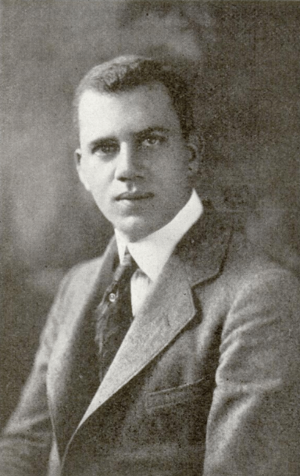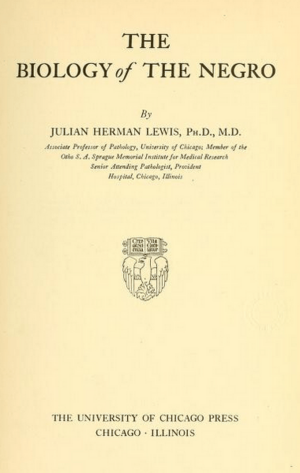Julian Herman Lewis facts for kids
Quick facts for kids
Julian Herman Lewis
|
|
|---|---|

Lewis circa 1922
|
|
| Born | May 26, 1891 |
| Died | March 6, 1989 (aged 97) |
| Education | BA, University of Illinois, 1911 MA, University of Illinois, 1912 PhD, University of Chicago, 1915 MD, Rush Medical College, 1917 |
| Occupation | Pathologist |
| Known for | The Biology of the Negro (1942) |
| Medical career | |
| Awards | Ricketts Prize (1915) Benjamin Rush Medal (1917) Guggenheim Fellowship (1926) |
Julian Herman Lewis (May 26, 1891 – March 6, 1989) was an important American scientist. He was a pathologist, which means he studied diseases and how they affect the body. Julian Lewis was the son of a freed slave. In 1922, he became the first African-American associate professor at the University of Chicago.
He was very interested in how different races might have different health characteristics. He also studied immunology, which is about how our bodies fight off sickness. In 1926, he received a special award called a Guggenheim Fellowship for his immunology research. His most famous work was a book called The Biology of the Negro, published in 1942. In this book, he shared his research and argued against the idea that black people were biologically less capable than others.
Contents
Early Life and Education
Julian Lewis was born on May 26, 1891. His hometown was Shawneetown, Illinois. His parents, John Calhoun Lewis and Cordelia O. Scott Lewis, were both schoolteachers. His father had been a slave but was freed.
Julian Lewis went to the University of Illinois at Urbana-Champaign. He studied biology and physiology there. He earned his first degree in 1911. He then got his master's degree from the same university in 1912. After that, he went to the University of Chicago. He completed his PhD in 1915. For his PhD research, he studied lipids and immunity. His work was so good that he won the Ricketts Prize.
In 1917, Lewis earned his medical degree (MD) from Rush Medical College. He also received the Benjamin Rush Medal for being an excellent student. In 1918, Julian Lewis married Eva Overton. They had three children together.
Career Highlights
Starting His Scientific Journey
After finishing medical school, Julian Lewis joined the pathology department at the University of Chicago. In 1920, he started working as a pathologist at Provident Hospital. This hospital served the African-American community in Chicago. He later became the chief pathologist there.
During his early years at the University of Chicago, Lewis worked with two important scientists. They were H. Gideon Wells and Ludvig Hektoen. Wells was a mentor to Lewis, guiding him throughout his career. Hektoen's research on blood groups helped Lewis in his own studies about medicine and race.
Hektoen had studied ABO blood types before. However, he had only looked at white subjects. In 1922, Lewis published his own paper. It was about the frequency of ABO blood types in African-Americans. This paper appeared in the Journal of the American Medical Association. Lewis showed that blood type distributions were different between white and black people. He pointed out that it was wrong to define what was "normal" based only on white people. This idea became a key part of his research.
Becoming a Professor
In 1922, the same year his paper was published, Lewis became an associate professor of pathology at the University of Chicago. He was the first African-American to hold such a position at the university. He stayed in this role until 1943.
Lewis received a grant in 1922 from the Sprague Institute. This grant helped him research "pathology among Negroes in all countries." In 1926, he earned a Guggenheim Fellowship. This allowed him to study immunology at the University of Basel in Switzerland.
The Biology of the Negro
In 1942, Julian Lewis published his most important work. It was a 400-page book called The Biology of the Negro. This book brought together medical and anthropological studies from over 1,300 different researchers. Lewis described his book as "nothing more than an arranged assembly of the observed and reported facts concerning the biology, including the pathology, of the Negro."
The book gave a detailed overview of scientific findings on racial differences. For example, it spent 35 pages discussing black skin. The book had nine chapters. The first three covered population facts, body structure, and how the body works. The other six chapters focused on how different diseases appeared in different races. Lewis paid special attention to sickle cell anemia. He believed this disease was found only in the black population.
Lewis noted that "many of the biological and environmental characteristics of the two peoples...show sharp contrasts." However, he strongly disagreed with using these differences to say that black people were less capable than white people. He argued that many physiological differences were actually helpful. For example, he noted that black people were more resistant to malaria. This resistance helped West Indian workers build the Panama Canal. He also dismissed research on racial differences in mental illness. He felt it was based on unfair stereotypes.
A review in the Journal of the National Medical Association in 1942 said something important. It stated that "the author failed to discover any fundamental evidence to show that the Negro is biologically inferior to other groups." This showed that Lewis's book supported equality.
Later Years and Legacy
H. Gideon Wells, Lewis's mentor, passed away in 1943. After this, Lewis's academic work changed. He stopped publishing research papers after 1943. In 1944, he took a leave from the university. The next year, he tried to get funding for a lab at Provident Hospital. This lab would study racial differences. The Sprague Institute agreed to fund it, but the lab was never built. The death of Lewis's wife that year might have played a role.
In his later career, Lewis worked at various local hospitals. He left Provident Hospital in 1952. He became the director of pathology at Our Lady of Mercy Hospital in Dyer, Indiana. He worked there until shortly before his death. Julian Lewis passed away on March 6, 1989.


